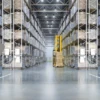A robotics revolution? Explore how robots can streamline fashion and lifestyle logistics in our latest Beyond Threads podcast!
Welcome to the latest edition of Bleckmann’s Beyond Threads podcast! In this episode, our host Erik Janssen Steenberg is joined by Bleckmann’s very own Director of Warehouse Solutions and Innovation, Kevin Paindeville, to explore the use of robotics in optimising the efficiency of warehouse storage and fulfilment logistics. To give you a taste, here are five key questions the two covered in their conversation.
How can robotics improve warehouse productivity?
Robots excel at repetitive tasks because they operate with speed and endurance, often outperforming humans over time. “While they may not always be faster than manual workers at completing tasks, a robot’s ability to work without breaks or fatigue often results in a significant net productivity boost,” said Kevin. “So, robots can take over certain monotonous tasks from warehouse workers, leaving them with more time to use their skills in more complex operational areas.”
Which robots are used in logistics and fulfilment?
Two of the most commonly used robots in warehouses are autonomous mobile robots (AMRs) and automated guided vehicles (AGVs). These efficiently transport items and pallets across warehouses and are used for picking and packing products on the active floor. Drones are also used to take cycle counts of inventory on case flow racking, enabling faster real-time stock management. Listen to the full episode for more examples of how robots are streamlining operations on the warehouse storage floor and beyond!
How do you build a business case for warehouse robots?
The journey for new robotic innovations is complex, from constructing early-stage concepts to implementing solutions in multiple warehouses. “We build business cases by analysing the potential efficiency gains that a robot could deliver for us,” explained Kevin. “If certain metrics line up, we then consider investing in the development or purchase of robots to help us provide an even more productive and efficient service to our customers.”
Do we still need humans?
The short answer is yes, absolutely. “As beneficial as robots are, especially in automating repetitive tasks, they are not capable of fixing issues or solving problems,” said Kevin. “You always need a human in the loop to troubleshoot or respond to problems that may arise.”
What developments are on the horizon for robotics in warehousing and fulfilment?
According to Kevin, the next frontier for robotics in logistics is focused on automating the unloading process at warehouse loading docks. “At Bleckmann, we’re experimenting with solutions such as suction cups, automated conveyors and mobile robots capable of grabbing and unloading items from trucks,” explained Kevin. “In the coming years, I’m convinced we’ll make progress in this area – and continue the fine work we’ve already done in automating specific areas of our warehouses!”
Want more expert insights on the future of robotics in fashion logistics? Press play now to get the full story!
__________________________________________________________________________________________________________________________
Transcript
Erik Janssen Steenberg: Hi there, and welcome to our Beyond Threads Podcast by Bleckmann. I'm your host, Erik Janssen Steenberg, and I'm thrilled to have you here again today. In each episode of Beyond Threads, we take a deep dive into development, innovations and all the trends in Logistics and Supply Chain Management. I'm joined today by Kevin Paindeville Bleckmann's very own Director of Warehouse Solutions and Innovations.
Kevin Paindeville: Thanks for having me, Erik, great to be here.
Erik Janssen Steenberg: Thank you for being here. Today's topic is Robotics in Warehousing and Logistics. So, I'm going to need your support.
Kevin Paindeville: Let's do this.
Erik Janssen Steenberg: Kevin, to start things off could you give us a brief introduction of who you are and what you do at Bleckmann? And top it off by what robotics means for Bleckmann and for our entire sector as a whole.
Kevin Paindeville: Sure. As you mentioned, my name is Kevin. I'm responsible at Bleckmann for Innovation, Warehouse Solutions and Design meaning the processes within the four walls of the warehouses. I'm working in the sector since 15 years looking at technology and streamlining processes. To come back to your question, robots in logistics can have various shapes, form factors. It can be AMR, AGV. AMR stands for Autonomous Mobile Robot. AGV: Automated Guided Vehicles. These are the robots driving and moving pallets with goods from A to B, for example. That's one form factor. You have robots able to pick items. You have robots able to pack items to create a carton around a group of items that need to be shipped to a consumer, for example. You have drones able to take cycle counts in your case racking. You have various types of robotics in logistics. You asked me about Bleckmann, what do we use? We do have a few types of robots. To be honest, not all of our warehouses are fully automated, we are not there yet. But we started early. It was even before my time at Bleckmann that they started with robotics. So, we do use some. We have some in production. We do have some in what we call UAT, in the testing phase. And we did implement some, and stop some. It is part of innovation. You try something, you try to validate an assumption. And you come to a conclusion: Not that one.
Erik Janssen Steenberg: You win some, you lose some.
Kevin Paindeville: I wouldn't say that. You win some, you learn some.
Erik Janssen Steenberg: Even better. You're right.
Kevin Paindeville: So, we do have some applications, but I guess we will dive into those now.
Erik Janssen Steenberg: Yes, thank you. Specifically the portion where you mention that not all of our locations are 100% automated. I, as a BD Manager, when I tour customers through our buildings indeed, I get the same remarks: Why is this not automated? And then I find it very hard to explain to them, or to convince them that robotics isn't always necessary, and isn't always a tool that will better the outcome. Is there anything that you can mention on pointers for customers or other members of the audience on how to determine if robotics is needed or not?
Kevin Paindeville: You are perfectly right. Let's make things clear: I love robots, I'd like to see robots everywhere. But if there is no point, if there is no business case, we will not do that. We are, like I said, pragmatic, and if we focus on a system process, we analyse it and we say: What are the various alternative ways to do the same process? Is it an alternative manual way, is it something with a robot, a conveyor, a picking machine? Depending on the process. And we compare those. And we do a business case, and then we see what the numbers say. We will not spend money, just for the sake of spending money. So, very important when you want to look into automation is to define a scope, because you can go very broad define a scope, define where you can do the most in savings. Take an assumption, validate this assumption. Do that in a controlled environment, where you can do a proof of concept. You can lease a robot or do a trial with a supplier. Let's validate the assumption and then do the business case in detail and check if there is a business case. One of the challenges for Bleckmann, which is a 3PL is, most of the time, the length of the contract. You sign a contract with a new customer, you sign, let's say, a five, four-year contract. A three, four, five-year contract. The first year, everybody is looking to see if what we forecasted in the contract Is materializing. And if it's okay, it's materialised...now we can think about automation, make some changes, optimise. And then you need to find a business case before the end of the contract. Or you need to discuss an eventual renewal of the contact. But it's not that easy.
Erik Janssen Steenberg: Even though I also sometimes feel like robotics is becoming more of a buzzword than an actual tool in your tool chest. But sometimes 'no' is the right answer. And by saying no you can look at your processes and people, and products even, differently instead of trying to build the best tool to cope with them.
Kevin Paindeville: And you said it, robots, robotics, it's a tool. It's one of the tools you have to do your job. It's not the only one. It's not the goal to have robots.
Erik Janssen Steenberg: Not at all. No, I agree. So, you have built more than a few business cases. You have tested an extensive range of those tools, robotics. And we have implemented and put live in a production operation a certain amount of those robot solutions. Can you explain how using those robots has improved our operational efficiency,accuracy, capabilities, etc.?
Kevin Paindeville: Robots are very good at automated repetitive tasks, for example. As a human, you have a certain productivity, the robot will do that faster. If we are speaking about cobots, sometimes it's the same pace, but it doesn't stop. That's the big difference. That doesn't mean that we will replace everybody by cobots or robots. Just that if there are repetitive tasks, it's not always fun to do repetitive tasks. So, we can just put in a robot, if there is a business case, of course and then assign those people, who were doing those tasks to other applications, other processes, where they can add their human added value, like I said. To come back to your question, sorry, I forgot the last part of your question.
Erik Janssen Steenberg: How these solutions have improved the process. So, on the one hand, they take away the repetitive, maybe tedious jobs without us having to lay off any staff, because we keep growing, et cetera. But have they also been beneficial for efficiency and accuracy levels, et cetera?
Kevin Paindeville: Yes, so we discussed the repetitive tasks. Some of them need to be augmented by vision technology because it's not always the same task. They need to pick something here, something there. The accuracy level gets better and better. And also by automating some tasks, we can gain in efficiency. Because everybody makes mistakes, we are human, it can happen, to have an error. A robot will not do that.
Erik Janssen Steenberg: No. Correct. But then again, a robot will also not solve an issue at hand.
Kevin Paindeville: No, but that's why you always need to have a human in the loop. That's terminology from AI, but having someone able to intervene if the robot gets stuck. Because the robot. Well, let's take an example, Erik. The robot needs to pick up that glass. He will try a few times. If he doesn't succeed after a few times, you can define a threshold he will stop and go in standby mode. And a human will need to intervene to help it. Either to teach him how to take it, or to solve it. There are different ways. It's important to have a human in the loop. To have that collaboration between the robot and a human.
Erik Janssen Steenberg: A very good example of how we are not at all focusing on cutting out the human factor in our processes. Very good. Okay. And when we look in terms of metrics and outcomes have you seen specific gains in, again, productivity, cost savings, coming from these robots being implemented?
Kevin Paindeville: Yes, I will give you one example of what we implemented. It was the first one, I don't take all credits, because it was implemented before my time. At one of our sites in Grobbendonk, near Antwerp...we implemented it there, for a customer, a return zone. You know when you order something, you order a lot of different sizes to be sure it will match your fit of the moment. And then you will send them back to the warehouse. Typically, when we handle returns, we check if it's saleable. And then we'll put it back on what we call the active floor, where the picking will occur. But we have a mezzanine. So, if you, for every article need to walk the stairs, go to the right location, put it back in the right place you take a lot of time. It costs money. So, with this customer, I will say they because I wasn't there Bleckmann decided with the customer to set up an area with robots. Those robots are AGV, able to move a shelf a shelf with location, a stock position. And those shelves will be brought to a pick station. It's also a kind of, or not a kind of It's a version of a goods-to-person solution. So, the picker, the operator, doesn't need to walk. The product will come to him or her. And then we decided to put that area close by the inbound dock. So, when we receive the return, we check them, we validate that they can be sold again. And then we put it directly into that zone, on the shelf. When you order a new item, we first check if that item is available in that area. And if it's there, we'll pick it from there and we will ship it. By implementing that solution, we increased the productivity of that process by 400%. That's huge. You cut out all the walking distance up to the second or third level of the mezzanine to put back the item. You put them in a specific location. It's a cage, because you can't walk there, it's an AGV, so there is no sensor you cannot see people walking into that. And that zone is dedicated to returns.
Erik Janssen Steenberg: So, if I conclude correctly, and understood you correctly that means that a return is processed automatically, saving on costs but it's also available much quicker to be sold again?
Kevin Paindeville: That was the highest requirement of the customer. He wanted to have the product back again on his website as fast as possible.
Erik Janssen Steenberg: Okay. So, that is indeed a two-sided gain. Very interesting. Well, robots are here to stay, they are not going away. And if anything, developments are going faster and faster. Also with AI, algorithms, etc. When we look in, let's say, 24 months' time, maybe 5 years: What is coming? What is beyond the horizon?
Kevin Paindeville: If I can speak about a Holy Grail, what a lot of suppliers are trying to achieve at the moment is the ability to unload a truck at the dock. Typically when you open the truck door at the warehouse, there are two ways: You either have the cartons on pallets, you take out the pallet. That's fairly easy. But you also have the loose loading way, where every carton is put in the truck a bit like Tetris. And you feel that when you open it, it's very well-filled. And there are a lot of players trying to come up with automated solutions to be able to unload those with robots. With suction caps, a conveyor. You also have mobile robots able to grab those.There are different form factors, there are different prices also. These are very high at the moment.
Erik Janssen Steenberg: Of course.
Kevin Paindeville: But we see, since a couple of months, a lot of movement in that field. And I think, if we wait 6 to 12 months, we'll see a lot of different solutions that will be much cheaper and interesting for us, and for all logistics.
Erik Janssen Steenberg: Yes, and that's of course, triggered due to the pressure on the labour market. But also, you want to be the employer of choice.
Kevin Paindeville: Exactly.
Erik Janssen Steenberg: You don't want people to be in the truck and moving cartons, Hauling around 50 kilos.
Kevin Paindeville: Exactly. Robotics is, of course, to be more efficient, to be more productive but also to remove all repetitive tasks from the scope of tasks for people. And also paying attention to the back and the well-being of our employees. It's not fun to empty a truck that way.
Erik Janssen Steenberg: No, I can imagine that becomes tedious very quickly.
Thank you very much for your insights, Kevin. And if you allow me to conclude: At Bleckmann, we look at robotics in such a way that robots are a tool, they're not the goal. They can be very beneficial to your bottom line and to the execution in your warehouse. But only after you have done a very good investigation on the type of product that you need, or the type of robots, and of course, the business case. Is there enough time, is there enough need to benefit from the investments made?
Kevin Paindeville: Exactly.
Erik Janssen Steenberg: Thank you very much for working on robotics for us as well at Bleckmann. And as always, I could talk to you for hours, but maybe we'll do that over a beer.
Thank you for being here.
Kevin Paindeville: You're welcome. Thanks for having me.
Erik Janssen Steenberg: And thank you very much for joining usfor this podcast. Stay tuned for the next. And I will see you there. Thank you.
















